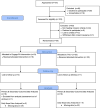Linking physical activity to personal values: feasibility and acceptability randomized pilot of a behavioral intervention for older adults with osteoarthritis pain
- PMID: 35915512
- PMCID: PMC9340681
- DOI: 10.1186/s40814-022-01121-0
Linking physical activity to personal values: feasibility and acceptability randomized pilot of a behavioral intervention for older adults with osteoarthritis pain
Abstract
Background: Osteoarthritis (OA) pain is common and leads to functional impairment for many older adults. Physical activity can improve OA outcomes for older adults, but few are appropriately active. Behavioral interventions can reduce physical activity barriers. We developed and tested a brief, novel behavioral intervention (i.e., Engage-PA) for older adults combining values to enhance motivation and strategic activity pacing to improve arthritis-related pain and functioning and increase physical activity.
Methods: A randomized feasibility and acceptability pilot trial compared Engage-PA to treatment-as-usual plus fitness tracker (TAU+) in N = 40 adults age 65+ with OA pain in the knee or hip. Engage-PA involved two 60-min telephone sessions. All participants wore a fitness tracker to collect daily steps throughout the study and completed baseline and post-treatment assessments of secondary outcomes (arthritis-related pain and physical functioning, physical activity, psychological distress, psychological flexibility, and valued living). The impact of COVID-19 on general well-being and physical activity was also assessed. Descriptive statistics were conducted for feasibility and acceptability outcomes. Indicators of improvement in secondary outcomes were examined via change scores from baseline to post-treatment and performing independent samples t-tests to assess for between-group differences.
Results: Feasibility was high; 100% accrual, low (5%) attrition, and 100% completion of study sessions. Acceptability was high, with 89% finding the intervention "mostly" or "very" helpful. Engage-PA participants demonstrated improvements in arthritis pain severity (Mdiff = 1.68, p = 0.044, 95% CI [- 0.26, 3.62]) and self-reported activity (Mdiff = 0.875, p = 0.038, 95% CI [- 1.85, 0.98]) from baseline to post-treatment as compared to TAU+. Due to pandemic-related challenges, there was a high level of missing data (43%) for daily steps, but available data showed no significant change in steps over time or between the groups. COVID-19 added an additional burden to participants, such that 50% were exercising less, 68% were more sedentary, and 72% lost access to spaces and social support to be active.
Conclusions: Engage-PA is a promising brief, novel behavioral intervention with the potential to support older adults in improving arthritis-related pain and functioning and increasing physical activity. The feasibility and acceptability of Engage-PA are particularly notable as most participants reported COVID-19 added more barriers to physical activity.
Trial registration: ClinicalTrials.gov, NCT04490395 . Registered on July 29, 2020.
Keywords: Osteoarthritis; Pain; Physical activity; Values.
© 2022. The Author(s).
Conflict of interest statement
Jennifer Plumb Vilardaga receives royalties from New Harbinger publications. The remaining authors declare that they have no competing interests.
Update of
-
Linking Physical Activity to Personal Values: Feasibility and Acceptability Randomized Pilot of a Behavioral Intervention for Older Adults with Osteoarthritis Pain.Res Sq [Preprint]. 2022 Jan 3:rs.3.rs-1182374. doi: 10.21203/rs.3.rs-1182374/v1. Res Sq. 2022. Update in: Pilot Feasibility Stud. 2022 Aug 1;8(1):164. doi: 10.1186/s40814-022-01121-0. PMID: 35018370 Free PMC article. Updated. Preprint.
Similar articles
-
Linking Physical Activity to Personal Values: Feasibility and Acceptability Randomized Pilot of a Behavioral Intervention for Older Adults with Osteoarthritis Pain.Res Sq [Preprint]. 2022 Jan 3:rs.3.rs-1182374. doi: 10.21203/rs.3.rs-1182374/v1. Res Sq. 2022. Update in: Pilot Feasibility Stud. 2022 Aug 1;8(1):164. doi: 10.1186/s40814-022-01121-0. PMID: 35018370 Free PMC article. Updated. Preprint.
-
Osteoarthritis physical activity care pathway (OA-PCP): results of a feasibility trial.BMC Musculoskelet Disord. 2020 May 16;21(1):308. doi: 10.1186/s12891-020-03339-6. BMC Musculoskelet Disord. 2020. PMID: 32416715 Free PMC article.
-
Effectiveness of a web-based physical activity intervention in patients with knee and/or hip osteoarthritis: randomized controlled trial.J Med Internet Res. 2013 Nov 22;15(11):e257. doi: 10.2196/jmir.2662. J Med Internet Res. 2013. PMID: 24269911 Free PMC article. Clinical Trial.
-
The usability and preliminary effectiveness of a web-based physical activity intervention in patients with knee and/or hip osteoarthritis.BMC Med Inform Decis Mak. 2013 May 28;13:61. doi: 10.1186/1472-6947-13-61. BMC Med Inform Decis Mak. 2013. PMID: 23714120 Free PMC article.
-
Telephone interventions for symptom management in adults with cancer.Cochrane Database Syst Rev. 2020 Jun 2;6(6):CD007568. doi: 10.1002/14651858.CD007568.pub2. Cochrane Database Syst Rev. 2020. PMID: 32483832 Free PMC article.
Cited by
-
Self-regulation of effort for a better health-related quality of life: a multidimensional activity pacing model for chronic pain and fatigue management.Ann Med. 2023;55(2):2270688. doi: 10.1080/07853890.2023.2270688. Epub 2023 Oct 23. Ann Med. 2023. PMID: 37871249 Free PMC article. Review.
-
'I've just heard that there are people who feel like they need to exercise': a photo-elicitation study of values and priorities influencing physical activity in a socioeconomically disadvantaged neighbourhood in Uppsala, Sweden.BMJ Open. 2024 Aug 29;14(8):e085356. doi: 10.1136/bmjopen-2024-085356. BMJ Open. 2024. PMID: 39209789 Free PMC article.
-
Can Wearable Device Promote Physical Activity and Reduce Pain in People with Chronic Musculoskeletal Conditions?J Clin Med. 2025 Feb 5;14(3):1003. doi: 10.3390/jcm14031003. J Clin Med. 2025. PMID: 39941673 Free PMC article. Review.
-
Reporting quality of interventions using a wearable activity tracker to improve physical activity in patients with inflammatory arthritis or osteoarthritis: a systematic review.Rheumatol Int. 2023 May;43(5):803-824. doi: 10.1007/s00296-022-05241-x. Epub 2022 Dec 1. Rheumatol Int. 2023. PMID: 36454326 Free PMC article.
References
-
- WHO | Information sheet: global recommendations on physical activity for health 65 years and above. WHO. Available from: https://www.who.int/dietphysicalactivity/publications/recommendations65y.... Cited 2020 Jan 28.
-
- Felson DT. The course of osteoarthritis and factors that affect it. Rheum Dis Clin North Am. 1993;19(3):607–615. - PubMed
-
- Marshall K, Hale D. Older adults and the opioid crisis. Home Healthc Now. 2019;37(2):117. - PubMed
-
- Physical activity helps arthritis pain | CDC. 2019. Available from: https://www.cdc.gov/arthritis/communications/features/physical-activity-.... Cited 2020 Sep 16.
Associated data
Grants and funding
LinkOut - more resources
Full Text Sources
Medical


